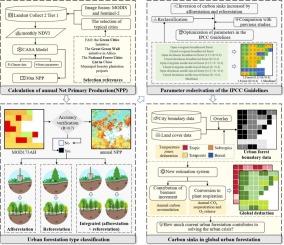A remote sensing-based assessment of biomass carbon global temporal trends in urban forests
IF 9.6
1区 环境科学与生态学
Q1 ENVIRONMENTAL STUDIES
引用次数: 0
Abstract
Urban forestation projects are being initiated to mitigate environmental issues, enhance climate change adaptation, and improve urban sustainability. In this study, we used Google Earth Engine (GEE) and Carnegie-Ames-Stanford Approach model (CASA) to evaluate the biomass carbon storage in 40 case cities with large-scale forestation projects. In 2010 and 2020, closed forests in cities of the tropical zones had the highest biomass carbon storage. Each of the three forestation patterns in the case cities - afforestation, reforestation and integrated (afforestation and reforestation) forestation - was orientated based on available local green space and urbanization trends. The study introduced refined carbon accumulation parameters based on climate zones and tree crown cover, generating a high-resolution spatial map of annual biomass carbon accumulation. From 2010 to 2020, the annual biomass carbon accumulation for urban forests (UFs) was 5.84 × 107 tC yr−1, equivalent to 0.58 tC ha−1 yr−1. The results can be used to assess the role of UFs in the carbon balance and mitigation of urban climate change. It can also provide guidance to urban planners in prioritizing the expansion of forestation areas and tree canopy cover for sustainable urban development, in accordance with climate and urban development conditions.

基于遥感的城市森林生物量碳全球时间趋势评估
实施城市造林工程,缓解环境问题,增强气候变化适应能力,提高城市可持续性。本研究采用谷歌Earth Engine (GEE)和Carnegie-Ames-Stanford Approach模型(CASA)对40个大型造林城市的生物质碳储量进行了评估。2010年和2020年,热带地区城市的封闭森林的生物量碳储量最高。案例城市的三种造林模式- -造林、再造林和综合(造林和再造林)造林- -每一种都是根据现有的当地绿色空间和城市化趋势确定的。该研究引入了基于气候带和树冠盖度的精细碳积累参数,生成了高分辨率的年生物量碳积累空间图。2010 ~ 2020年,城市森林年生物量碳累积量为5.84 × 107 tC yr - 1,相当于0.58 tC ha - 1 yr - 1。研究结果可用于评估UFs在碳平衡和减缓城市气候变化中的作用。它还可以为城市规划者提供指导,根据气候和城市发展条件,优先扩大造林面积和树冠覆盖率,促进城市可持续发展。
本文章由计算机程序翻译,如有差异,请以英文原文为准。
求助全文
约1分钟内获得全文
求助全文
来源期刊

Sustainable Production and Consumption
Environmental Science-Environmental Engineering
CiteScore
17.40
自引率
7.40%
发文量
389
审稿时长
13 days
期刊介绍:
Sustainable production and consumption refers to the production and utilization of goods and services in a way that benefits society, is economically viable, and has minimal environmental impact throughout its entire lifespan. Our journal is dedicated to publishing top-notch interdisciplinary research and practical studies in this emerging field. We take a distinctive approach by examining the interplay between technology, consumption patterns, and policy to identify sustainable solutions for both production and consumption systems.
 求助内容:
求助内容: 应助结果提醒方式:
应助结果提醒方式:


